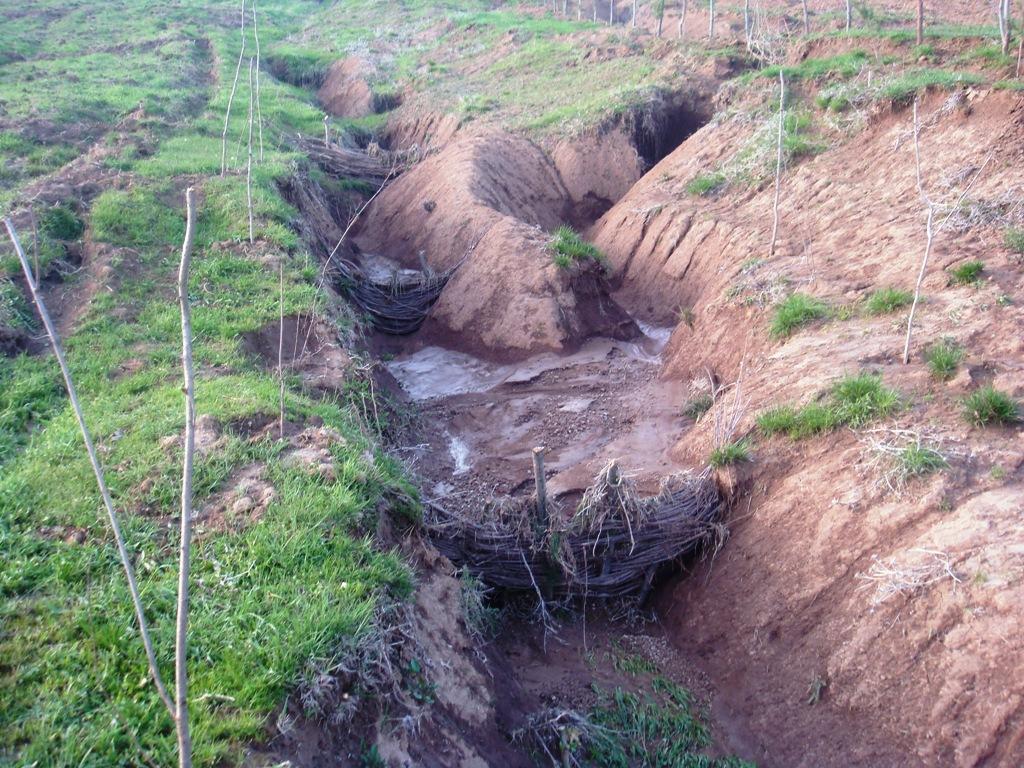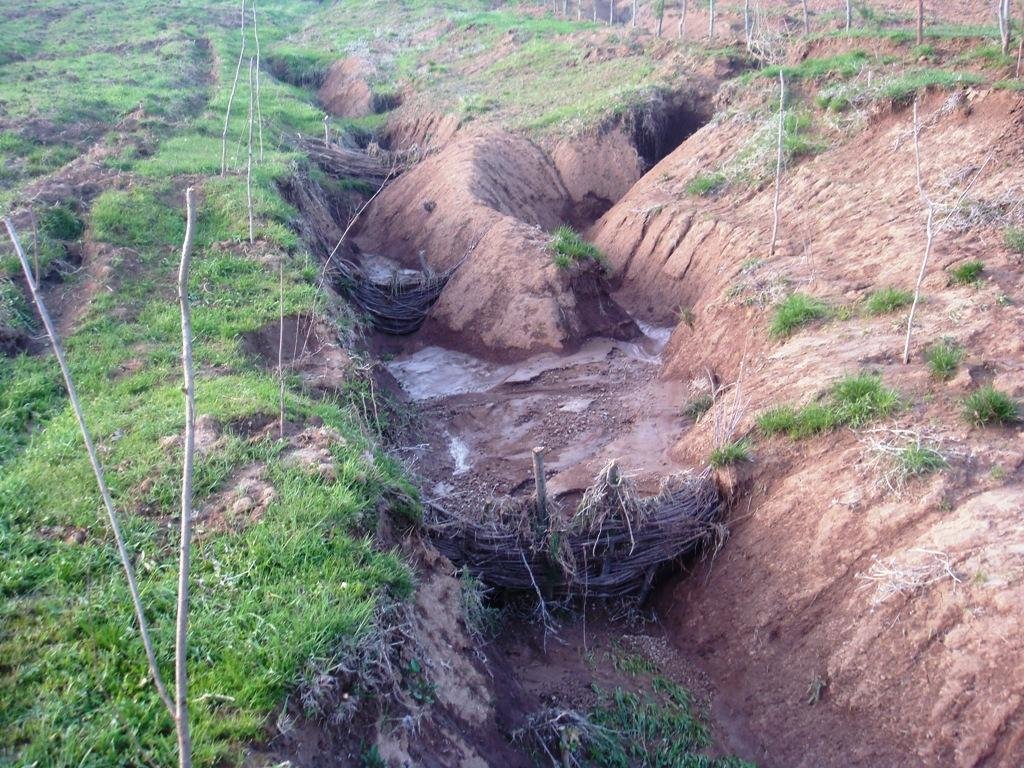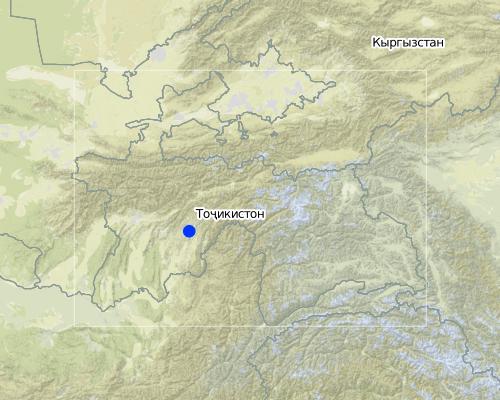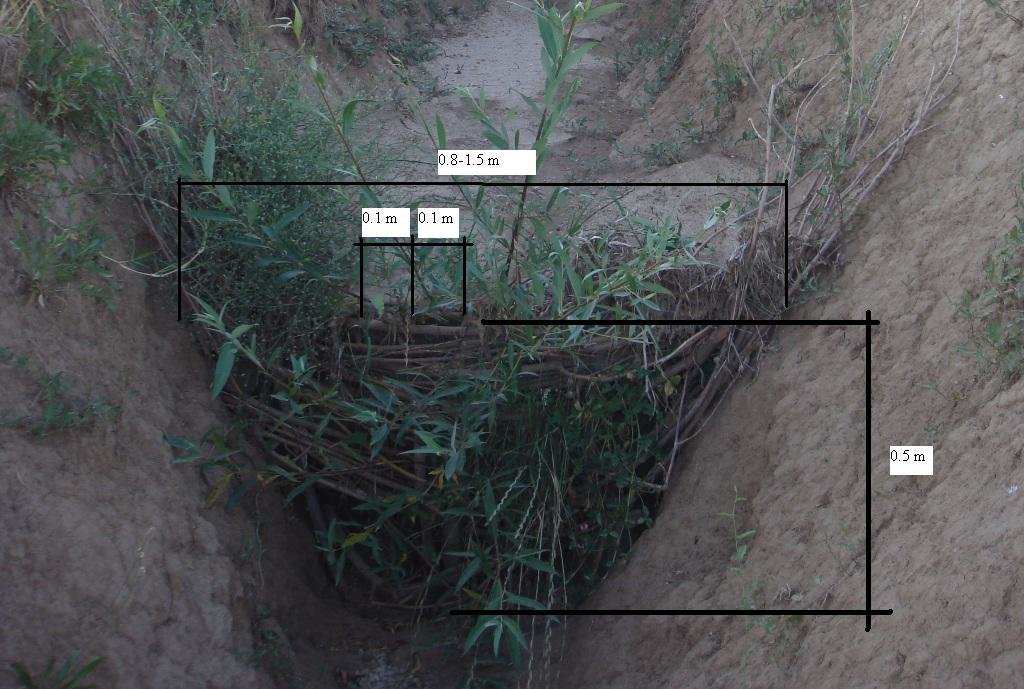Infilling of gullies with vegetative structures [Tajikistan]
- Creation:
- Update:
- Compiler: Daler Domullojonov
- Editor: –
- Reviewer: David Streiff
Пуркунии селрохахо
technologies_1450 - Tajikistan
View sections
Expand all Collapse all1. General information
1.2 Contact details of resource persons and institutions involved in the assessment and documentation of the Technology
SLM specialist:
Barotov Bahrom
Welthungerhilfe
Tajikistan
SLM specialist:
Ashurov Bakhtiyor
Welthungerhilfe
Tajikistan
Name of the institution(s) which facilitated the documentation/ evaluation of the Technology (if relevant)
Deutsche Welthungerhilfe e. V. (Welthungerhilfe) - Tajikistan1.3 Conditions regarding the use of data documented through WOCAT
When were the data compiled (in the field)?
01/05/2011
The compiler and key resource person(s) accept the conditions regarding the use of data documented through WOCAT:
Yes
2. Description of the SLM Technology
2.1 Short description of the Technology
Definition of the Technology:
Reclamation and infilling of eroded gullies using barriers of willow branches and live mulberry cuttings to trap loess soil from surface water runoff.
2.2 Detailed description of the Technology
Description:
Due to many different factors and mechanisms, soil erosion is at an advanced stage in many of the hilly and mountainous parts of Tajikistan. After disrupting the soil cover in steep areas, starting the process of soil detachment and transportation water runoff gets concentrated into specific areas. As a result, rills develop on the steep areas, and eventually enlarge into gullies.
Purpose of the Technology: To address this problem, low cost barriers are constructed from flexible living branches of a sprouting variety of tree, such as willow. These branches are placed along the gulley at intervals of 3-10 metres, so that they slow down the flow of surface water and trap the sediment, thus eventually filling in the gulley over a period of several years.
Establishment / maintenance activities and inputs: The barriers are designed to slowly help infill eroded gullies by trapping the sediment from muddy surface water runoff. This helps prevent further erosion, increases the amount of land available for pasture, and reduces the risk of mud flows or floods further down the slope.
In gullies no wider than 1-2m, live cuttings from local tree varieties with a diameter of 3-5cm and 1 metre in length can be used to establish horizontal woven barriers across the gulley. The barriers are placed at 3-5m intervals along the gulley, starting at the base.
These barriers are constructed from cuttings that are woven in narrow sections with 5-6cm intervals between them. Enforcement and strengthening of these plugs can be achieved through the use of long branches of locally available mulberry. The height of the plug should not exceed 0.5m. The construction activities start in the spring and within several weeks some of the cuttings begin to sprout and grow. To avoid erosion at the sides of the structure, the cut offs are embedded into the sides of the gulley.
Natural / human environment: Gulley plugging is used in pasture land that suffers from overgrazing, deforestation and trampling, which has resulted in the degradation of the soil. Subsequently, the soil has become more vulnerable to the impact of heavy rain in the spring and autumn months, and is prone to erosion from surface water runoff.
2.3 Photos of the Technology
2.5 Country/ region/ locations where the Technology has been applied and which are covered by this assessment
Country:
Tajikistan
Region/ State/ Province:
Tajikistan / Khatlon
Further specification of location:
Khovaling / Dorobi
Map
×2.6 Date of implementation
If precise year is not known, indicate approximate date:
- less than 10 years ago (recently)
2.7 Introduction of the Technology
Specify how the Technology was introduced:
- through projects/ external interventions
Comments (type of project, etc.):
The technology was developed and promoted using the framework of EC TACIS funded Welthungerhilfe project in Khatlon
3. Classification of the SLM Technology
3.1 Main purpose(s) of the Technology
- reduce, prevent, restore land degradation
3.2 Current land use type(s) where the Technology is applied

Grazing land
Extensive grazing land:
- Semi-nomadism/ pastoralism
Main animal species and products:
cows, goats, sheep
Comments:
Major land use problems (compiler’s opinion): Overgrazing on pasture lands, that leads to reduced vegetation cover and deforestation, contributes greatly to the causes of top soil erosion and gulley formation.
Major land use problems (land users’ perception): Gullies are formed after intensive rainfall events. There is nothing in place to stop this erosion.
Semi-nomadism / pastoralism: cows, goats. sheep
Grazingland comments: There is local grazing on this land, but some areas are subjected to nomadic grazing during the migration of livestock between the winter and summer pastures.
Future (final) land use (after implementation of SLM Technology): Mixed: Mf: Agroforestry
Type of grazing system comments: There is local grazing on this land, but some areas are subjected to nomadic grazing during the migration of livestock between the winter and summer pastures.
If land use has changed due to the implementation of the Technology, indicate land use before implementation of the Technology:
Grazing land: Ge: Extensive grazing land
3.3 Further information about land use
Water supply for the land on which the Technology is applied:
- rainfed
Number of growing seasons per year:
- 1
Specify:
Longest growing period in days: 160Longest growing period from month to month: March - June
Livestock density (if relevant):
1-10 LU /km2
3.4 SLM group to which the Technology belongs
- cross-slope measure
3.5 Spread of the Technology
Specify the spread of the Technology:
- evenly spread over an area
If the Technology is evenly spread over an area, indicate approximate area covered:
- < 0.1 km2 (10 ha)
Comments:
Total area covered by the SLM Technology is 0.017 m2.
Approximately an 800 m long eroded gully was reclaimed.
3.6 SLM measures comprising the Technology

vegetative measures
- V1: Tree and shrub cover

structural measures
- S6: Walls, barriers, palisades, fences
Comments:
Main measures: vegetative measures, structural measures
Type of vegetative measures: aligned: -linear
3.7 Main types of land degradation addressed by the Technology

soil erosion by water
- Wg: gully erosion/ gullying
Comments:
Main type of degradation addressed: Wg: gully erosion / gullying
Main causes of degradation: deforestation / removal of natural vegetation (incl. forest fires) (Trees were cut from a steep slope on the side of the hillside.), overgrazing (Freely grazed area, carrying capacity less than animal numbers grazing.)
Secondary causes of degradation: Heavy / extreme rainfall (intensity/amounts) (More intensive rainfall.), land tenure (Lack of control of livestock grazing activities.), poverty / wealth, war and conflicts (Gullies appeared after civil war.)
3.8 Prevention, reduction, or restoration of land degradation
Specify the goal of the Technology with regard to land degradation:
- restore/ rehabilitate severely degraded land
4. Technical specifications, implementation activities, inputs, and costs
4.1 Technical drawing of the Technology
4.2 Technical specifications/ explanations of technical drawing
For the plugging of the gully, a low cost and simple barrier was made from locally available fast sprouting species of trees; in this case live willow cuttings were used. In the gully a narrow section was selected, and cuttings (3-5 cm diameter, 1 m length) were placed in a line with 10 cm intervals in between. One third of the cuttings were planted in the gulley, and the rest were used to create a 'wave' wall of flexible branches, which was planted with local mulberry trees (1-1.5 cm diameter). The weaved branches have to be pushed down from the top to make the barrier suitably dense. The ends of the mulberry branches have to be stuck securely to the soil inside the gulley.
Location: Dorobi village. Khovaling / Khatlon / Tajikistan
Date: 2nd July, 2010
Technical knowledge required for field staff / advisors: moderate
Technical knowledge required for land users: moderate
Main technical functions: control of concentrated runoff: impede / retard, stabilisation of soil (eg by tree roots against land slides)
Secondary technical functions: improvement of ground cover, increase of surface roughness, sediment retention / trapping, sediment harvesting
Aligned: -linear
Vegetative material: T : trees / shrubs
Vertical interval within rows / strips / blocks (m): 0.2
Trees/ shrubs species: mulberry
Retention/infiltration ditch/pit, sediment/sand trap
Vertical interval between structures (m): 3-5
Depth of ditches/pits/dams (m): 0.5
Width of ditches/pits/dams (m): 1.5
Length of ditches/pits/dams (m): 0.5
Construction material (wood): Willow and mulberry branches
Vegetation is used for stabilisation of structures.
4.3 General information regarding the calculation of inputs and costs
other/ national currency (specify):
Tajik Somoni
Indicate exchange rate from USD to local currency (if relevant): 1 USD =:
4.5
Indicate average wage cost of hired labour per day:
5.50 $
4.4 Establishment activities
| Activity | Type of measure | Timing | |
|---|---|---|---|
| 1. | planting mulberry in willow wave structure | Vegetative | spring |
| 2. | establishment of barriers in gully bed | Structural | once in the beginning |
4.5 Costs and inputs needed for establishment
| Specify input | Unit | Quantity | Costs per Unit | Total costs per input | % of costs borne by land users | |
|---|---|---|---|---|---|---|
| Labour | Planting mulberry | Persons/day | 1.0 | 25.0 | 25.0 | 100.0 |
| Labour | Establishment of barriers in gully | Persons/day | 1.0 | 25.0 | 25.0 | 100.0 |
| Plant material | Mulberry seedlings | Pieces | 20.0 | 1.0 | 20.0 | 100.0 |
| Construction material | Willow cuttings | Pieces | 20.0 | 1.0 | 20.0 | 100.0 |
| Total costs for establishment of the Technology | 90.0 | |||||
Comments:
Duration of establishment phase: 12 month(s)
4.6 Maintenance/ recurrent activities
| Activity | Type of measure | Timing/ frequency | |
|---|---|---|---|
| 1. | Reinforce structure with additional seedlings when needed | Vegetative | annually |
| 2. | establishment of additional barriers after filling existing barriers with sediments | Structural | once per year in beginning of rainy season |
4.7 Costs and inputs needed for maintenance/ recurrent activities (per year)
| Specify input | Unit | Quantity | Costs per Unit | Total costs per input | % of costs borne by land users | |
|---|---|---|---|---|---|---|
| Labour | Reinforce structure | Persons/day | 1.0 | 25.0 | 25.0 | 100.0 |
| Labour | Establishment of additional barriers | Persons/day | 1.0 | 25.0 | 25.0 | 100.0 |
| Plant material | Mulberry seedlings | Pieces | 20.0 | 1.0 | 20.0 | 100.0 |
| Construction material | Willow cuttings | Pieces | 20.0 | 1.0 | 20.0 | 100.0 |
| Total costs for maintenance of the Technology | 90.0 | |||||
Comments:
The unit cost is for a gulley plug, 1.5 metre wide and around 1m in height.
4.8 Most important factors affecting the costs
Describe the most determinate factors affecting the costs:
The materials used to construct the gulley plug are locally available, and are therefore free of charge to the land user. The labour (or time in labour) is the most substantial cost, and this is directly proportional to the number of gulley plugs required to infill the entire eroded gulley. If there is a big sediment load in the surface water runoff it will back fill behind the gulley plugs rapidly and additional barriers will need to be established.
5. Natural and human environment
5.1 Climate
Annual rainfall
- < 250 mm
- 251-500 mm
- 501-750 mm
- 751-1,000 mm
- 1,001-1,500 mm
- 1,501-2,000 mm
- 2,001-3,000 mm
- 3,001-4,000 mm
- > 4,000 mm
Specifications/ comments on rainfall:
Precipitation is concentrated during the autumn and spring, averaging 1100-1200mm
Agro-climatic zone
- semi-arid
Thermal climate class: temperate. 3 months below 5 degrees, 7 months above 10 degrees
5.2 Topography
Slopes on average:
- flat (0-2%)
- gentle (3-5%)
- moderate (6-10%)
- rolling (11-15%)
- hilly (16-30%)
- steep (31-60%)
- very steep (>60%)
Landforms:
- plateau/plains
- ridges
- mountain slopes
- hill slopes
- footslopes
- valley floors
Altitudinal zone:
- 0-100 m a.s.l.
- 101-500 m a.s.l.
- 501-1,000 m a.s.l.
- 1,001-1,500 m a.s.l.
- 1,501-2,000 m a.s.l.
- 2,001-2,500 m a.s.l.
- 2,501-3,000 m a.s.l.
- 3,001-4,000 m a.s.l.
- > 4,000 m a.s.l.
Comments and further specifications on topography:
Altitudinal zone: 1257 m a.s.l.
Slopes on average: Average slope 12.6%, max slope 17.2%
5.3 Soils
Soil depth on average:
- very shallow (0-20 cm)
- shallow (21-50 cm)
- moderately deep (51-80 cm)
- deep (81-120 cm)
- very deep (> 120 cm)
Soil texture (topsoil):
- medium (loamy, silty)
Topsoil organic matter:
- low (<1%)
If available, attach full soil description or specify the available information, e.g. soil type, soil PH/ acidity, Cation Exchange Capacity, nitrogen, salinity etc.
Soil texture = loess soil
Soil fertility is low due to over use and lack of fallow time.
Soil drainage / infiltration is poor
Soil water storage capacity is low
5.4 Water availability and quality
Ground water table:
> 50 m
Availability of surface water:
poor/ none
Water quality (untreated):
good drinking water
Comments and further specifications on water quality and quantity:
Availability of surface water: In the area around the gulley the land is compacted.
5.5 Biodiversity
Species diversity:
- low
5.6 Characteristics of land users applying the Technology
Market orientation of production system:
- subsistence (self-supply)
Off-farm income:
- 10-50% of all income
Relative level of wealth:
- poor
- average
Individuals or groups:
- groups/ community
Gender:
- men
Indicate other relevant characteristics of the land users:
Land users applying the Technology are mainly common / average land users
Population density: 10-50 persons/km2
Annual population growth: 1% - 2%; 2%
20% of the land users are average wealthy.
80% of the land users are poor.
5.7 Average area of land owned or leased by land users applying the Technology
- < 0.5 ha
- 0.5-1 ha
- 1-2 ha
- 2-5 ha
- 5-15 ha
- 15-50 ha
- 50-100 ha
- 100-500 ha
- 500-1,000 ha
- 1,000-10,000 ha
- > 10,000 ha
Is this considered small-, medium- or large-scale (referring to local context)?
- small-scale
5.8 Land ownership, land use rights, and water use rights
Land ownership:
- state
Land use rights:
- leased
5.9 Access to services and infrastructure
health:
- poor
- moderate
- good
education:
- poor
- moderate
- good
technical assistance:
- poor
- moderate
- good
employment (e.g. off-farm):
- poor
- moderate
- good
markets:
- poor
- moderate
- good
energy:
- poor
- moderate
- good
roads and transport:
- poor
- moderate
- good
drinking water and sanitation:
- poor
- moderate
- good
financial services:
- poor
- moderate
- good
6. Impacts and concluding statements
6.1 On-site impacts the Technology has shown
Socio-economic impacts
Production
wood production
Comments/ specify:
The trees can be harvested once the gulley is full of sediment.
production area
Quantity before SLM:
1.5
Quantity after SLM:
1.6
Comments/ specify:
Gully filling can help create new areas of arable land.
Socio-cultural impacts
SLM/ land degradation knowledge
Livelihood and human well-being
Ecological impacts
Water cycle/ runoff
surface runoff
Soil
soil cover
soil loss
Comments/ specify:
Sediments are trapped
Climate and disaster risk reduction
landslides/ debris flows
6.2 Off-site impacts the Technology has shown
downstream flooding
buffering/ filtering capacity
damage on neighbours' fields
damage on public/ private infrastructure
6.3 Exposure and sensitivity of the Technology to gradual climate change and climate-related extremes/ disasters (as perceived by land users)
Gradual climate change
Gradual climate change
| Season | Type of climatic change/ extreme | How does the Technology cope with it? | |
|---|---|---|---|
| annual temperature | increase | not known |
Climate-related extremes (disasters)
Meteorological disasters
| How does the Technology cope with it? | |
|---|---|
| local rainstorm | well |
| local windstorm | not known |
Climatological disasters
| How does the Technology cope with it? | |
|---|---|
| drought | not well |
Hydrological disasters
| How does the Technology cope with it? | |
|---|---|
| general (river) flood | not well |
Other climate-related consequences
Other climate-related consequences
| How does the Technology cope with it? | |
|---|---|
| reduced growing period | not known |
Comments:
As a living barrier it needs to grow, and therefore it is sensitive to drought conditions.
6.4 Cost-benefit analysis
How do the benefits compare with the establishment costs (from land users’ perspective)?
Short-term returns:
neutral/ balanced
Long-term returns:
positive
How do the benefits compare with the maintenance/ recurrent costs (from land users' perspective)?
Short-term returns:
neutral/ balanced
Long-term returns:
positive
6.5 Adoption of the Technology
- more than 50%
If available, quantify (no. of households and/ or area covered):
10 households in an area of 1.7 ha
Of all those who have adopted the Technology, how many have did so spontaneously, i.e. without receiving any material incentives/ payments?
- 90-100%
Comments:
100% of land user families have adopted the Technology without any external material support
10 land user families have adopted the Technology without any external material support
There is a little trend towards spontaneous adoption of the Technology
Comments on adoption trend: There is little trend towards (growing) spontaneous adoption of the technology.
6.7 Strengths/ advantages/ opportunities of the Technology
| Strengths/ advantages/ opportunities in the land user’s view |
|---|
|
No training and additional skills are required. How can they be sustained / enhanced? Broad promotion to other communities with similar climatic conditions and similar issues. |
| It is low cost option. |
| Easy to establish, with a low workload. |
| Strengths/ advantages/ opportunities in the compiler’s or other key resource person’s view |
|---|
|
Gulley plugs are relatively easy to construct and have a low initial outlay. How can they be sustained / enhanced? It could be further supported by the strong involvement of local authorities, through the organisation of cross visits, and disseminating ideas between farmers. |
| It is flexible as various varieties of local sprouting trees can be used to build the gulley plug. |
| It can prevent further erosion and expansion of the gulley. It can also increase the amount of land available for pasture activities. |
| Environmentally friendly |
6.8 Weaknesses/ disadvantages/ risks of the Technology and ways of overcoming them
| Weaknesses/ disadvantages/ risks in the compiler’s or other key resource person’s view | How can they be overcome? |
|---|---|
| The gulley plug is weak in the beginning as the mulberry trees become more established. It is more susceptible to the impact of heavy rainfall events and concentrated run off down the gulley. | High levels of maintenance in the first initial few seasons. |
| The gulley plug becomes less effective as the gullies become wider and deeper. | Fencing around the gulley. |
| The gulley plug has to be protected from livestock who will eat the vegetation. |
7. References and links
7.2 References to available publications
Title, author, year, ISBN:
Welthungerhilfe project final narrative report (144-912) - 2010
Available from where? Costs?
Welthungerhilfe projects in Khatlon region, Temurmalik district
Links and modules
Expand all Collapse allLinks
No links
Modules
No modules






